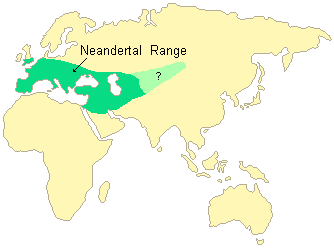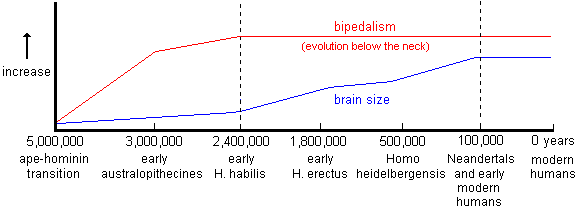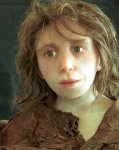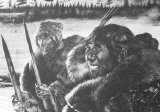 |
|
|
Neandertal hunters |
The most well-known
late archaic humans were the Neandertals
![]() .
More Neandertal skeletons have been found than any other ancient human
species. They lived in Europe and Southwest Asia from
at least 130,000 years ago until
around 28,000 years ago.
This is in the late Pleistocene Epoch.
It is likely that the Neandertals evolved from Homo heidelbergensis in Southern Europe. Neandertal-like
skull characteristics have been found in 400,000 year old fossils from Spain.
The Neandertals adapted physically and culturally to the ice age conditions
that prevailed during much of their time.
.
More Neandertal skeletons have been found than any other ancient human
species. They lived in Europe and Southwest Asia from
at least 130,000 years ago until
around 28,000 years ago.
This is in the late Pleistocene Epoch.
It is likely that the Neandertals evolved from Homo heidelbergensis in Southern Europe. Neandertal-like
skull characteristics have been found in 400,000 year old fossils from Spain.
The Neandertals adapted physically and culturally to the ice age conditions
that prevailed during much of their time.
No other ancient people have aroused more controversy and
confusion over the last century and a half than have the Neandertals. There is an on-going debate as to whether they should be considered
Homo
sapiens. If they were members of our species, they were a different
variety or race (Homo sapiens neanderthalensis). On the other hand, if
they were dissimilar enough to be a distinct
species, they should be called Homo neanderthalensis
![]() .
.
|
Important Neandertal Sites |
|||||||||||||||||||||||||||||||||||||||||||||||||||||||||||||||||||||||||||
|
|
|
|
|||||||||||||||||||||||||||||||||||||||||||||||||||||||||||||||||||||||||
Neandertal
Discoveries
The first discovery of Neandertal bones may have been during the late 1820's in Western Europe. Subsequently, other, better documented Neandertals were found and stored in museums without being recognized as early forms of humans. In 1839, for instance, a portion of a child's skeleton was found in Engis, Belgium. In 1848, an adult female skull was found at Gibraltar, at the southern tip of Spain.
|
|
|
|
Johan Karl Fuhlrott |
In 1856 a discovery
was made in Germany that finally sparked the recognition that these were, in
fact, not just strange looking modern people. This was
the discovery of a skull and a number of other bones from a limestone cave
deposit in the small Neander River Valley near Dïüsseldorf. Thinking that they
were from a bear, the quarrymen gave them to a local school teacher and amateur naturalist,
Johan
Karl Fuhlrott
![]() . He recognized them as being human but somewhat different
from those of modern Europeans. When several leading paleontologists
and medical pathologists in Germany became aware of the fossils, a disagreement
developed about who the "Neandertal Man" might have been.
It was suggested that he had been an old Roman, a Dutchman, and even a Central
Asian soldier in the service of the Russian czar during the Napoleonic
wars of the
early 19th century. The reality that these bones were from an earlier
variety or species of human was not yet conceivable to most
of the scientific world in
the 1850's.
. He recognized them as being human but somewhat different
from those of modern Europeans. When several leading paleontologists
and medical pathologists in Germany became aware of the fossils, a disagreement
developed about who the "Neandertal Man" might have been.
It was suggested that he had been an old Roman, a Dutchman, and even a Central
Asian soldier in the service of the Russian czar during the Napoleonic
wars of the
early 19th century. The reality that these bones were from an earlier
variety or species of human was not yet conceivable to most
of the scientific world in
the 1850's.
What finally convinced the scientific community that Neandertals were very ancient Europeans was a combination of additional fossil discoveries and new perspectives that largely began with the publication of Charles Darwin's On the Origin of Species in 1859. This seminal work in biology popularized the idea that species of living things evolve over time as a result of natural selection. Subsequently, it was not a major leap in understanding to realize that humans also must have evolved from earlier forms. In fact, Darwin proposed just that in his 1871 influential publication The Descent of Man, and Selection in Relation to Sex. For enlightened Victorians, the Neandertals ultimately came to be seen as important human ancestors. They were given the name "Neandertal Man" in 1864 by William King, an Irish anatomist. He named them after the Neander River Valley (or Tal, in German).
NOTE: In many older books, Neandertal is spelled with a "thal" ending (Neanderthal) instead of "tal". This is the Old German spelling that was replaced in the early 20th century. However, the outdated usage of "thal" persists in some English publications. It is also continued in scientific classification (Homo neanderthalensis) because it was used when Neandertal's were first described in the 19th century. In this tutorial series, the modern "tal" is used.
In 1886, two Neandertal skeletons were found in a Belgium cave site named Spy. These specimens were physically associated with stone tools and food refuse bones from extinct ice age animals. This evidence once and for all demonstrated that Neandertals were not modern people. As a result, the majority of European paleontologists in the late 1880's finally accepted them for what they really were.

|
|
|
Marcellin Boule
|
The remains of more
than 400 Neandertals have been found. The most controversial one was
excavated in 1908 at La Chapelle-aux-Saints
![]() in southwestern France. This is a nearly
complete skeleton of a man who would have been elderly by Neandertal
standards. The bones were analyzed between 1911 and 1913 by the noted
French paleontologist, Marcellin Boule
in southwestern France. This is a nearly
complete skeleton of a man who would have been elderly by Neandertal
standards. The bones were analyzed between 1911 and 1913 by the noted
French paleontologist, Marcellin Boule
![]() . Unfortunately, Boule's
prejudices got in the way of scientific objectivity. He described the La
Chapelle-aux-Saints man, and subsequently all Neandertals, as dull-witted,
brutish, ape-like creatures who walked hunched over with a shuffling gait.
Unfortunately, this mistaken view was universally accepted by paleoanthropologists for decades. It also
became the source of the popular images of dim-witted cavemen that still
appear in cartoons and movies.
. Unfortunately, Boule's
prejudices got in the way of scientific objectivity. He described the La
Chapelle-aux-Saints man, and subsequently all Neandertals, as dull-witted,
brutish, ape-like creatures who walked hunched over with a shuffling gait.
Unfortunately, this mistaken view was universally accepted by paleoanthropologists for decades. It also
became the source of the popular images of dim-witted cavemen that still
appear in cartoons and movies.
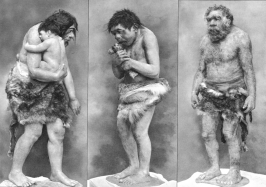 |
Diorama of Neandertals in an American museum during the 1930's reflecting the misconception reinforced by Marcellin Boule's description of them as dull-witted, brutish, ape-like creatures. |
After reanalysis of the La Chapelle-aux-Saints skeleton in the 1950's, it became clear that a serious mistake had been made. This had been an atypical Neandertal. He was at least 40 years old with a somewhat hunched over posture resulting from severe arthritis in his spine. There was a bowing of his legs that may have resulted from rickets disease in childhood. He had lost most of his teeth and part of his jaw resulting in a disharmonic looking face. Despite these deforming infirmities, it is now clear that the La Chapelle-aux-Saints man was much more like us in appearance, intelligence, and physical ability than had been believed by Marcellin Boule.
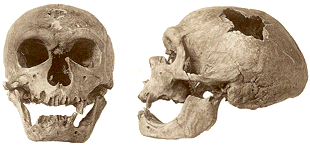 |
| La Chapelle-aux-Saints man |
Analysis
of Neandertal Anatomy
The Neandertals were physically diverse, but in general they were larger boned and more heavily muscled than most modern humans. This was particularly true of the European Neandertals, like the La Chapelle-aux-Saints man. Some of the Southwest Asian Neandertals were less robust in appearance and somewhat more like modern humans. The Neandertals were relatively short and stocky compared to some other archaic humans and modern Europeans. Adult male Neandertals averaged 5 feet 5 inches tall (164 cm.) and 143 pounds (65 kg). Females averaged 5 feet 1 inch tall (155 cm) and 119 pounds (54 kg). They probably stood as erect as we do and were fully bipedal. They were not only strong but apparently quite flexible. The thickness and high density of their leg bones suggest that they did a great deal of walking and running. Their lower arm and leg bones were short compared to modern humans. These traits were likely adaptations to an aggressive hunting and gathering way of life as well as to the cold climates in which most Neandertals lived. The fact that adult Neandertal skeletons frequently have multiple healed bone fractures suggests that these people had rough lives. Some researchers believe that many of the broken bones were the result of hunting large game animals up close with jabbing spears--a dangerous enterprise.
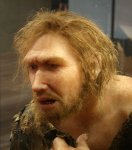 |
|
| Reconstruction of the Neandertal appearance |
It is likely that at least some Neandertals had pale skin color and red hair. This is based on the discovery of a variant of the MC1R gene associated with these traits in the bones of two European Neandertals dated to around 50,000 years ago. This was very likely an adaptation that helped their bodies produce more Vitamin D and subsequently absorb more calcium from their food in ice age Europe.
Neandertal heads were long (from front to back) compared to ours. This
resulted in relatively low, sloping foreheads. At the back of
their skulls, they had a prominent bulge or projection called an occipital bun
![]() . They had
large faces (especially in the middle part) with big noses and
prominent brow
ridges that extended between the eyes. They lacked the pointed chin that is common in modern
Homo sapiens.
These traits give the Neandertal face and head an appearance more reminiscent
of late Homo erectus and Homo heidelbergensis
than of modern people.
. They had
large faces (especially in the middle part) with big noses and
prominent brow
ridges that extended between the eyes. They lacked the pointed chin that is common in modern
Homo sapiens.
These traits give the Neandertal face and head an appearance more reminiscent
of late Homo erectus and Homo heidelbergensis
than of modern people.
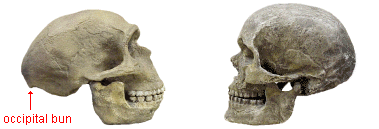 |
|
| Neandertal | Modern human |
The brain size of Neandertals was close to that of modern humans, and the structural organization of their brains was essentially the same as well. The average Neandertal brain was actually somewhat larger than the brains of most people today. However, the difference is minimal when people of similar body size are compared. In fact, the average Neandertal brain may have been slightly smaller from this perspective. The large heads and stocky bodies of Neandertals very likely were more efficient in cold climates and were probably selected for by nature. This trend has been observed among contemporary Native American populations living in sub-arctic environments. A larger head and more compact body shape potentially produce more body heat relative to the amount that is lost to the environment through radiation. A bigger brain carries a high energy overhead. The human brain uses around 20% of the energy that we get from our food when we are resting, but it is only 2% of our body mass. This is one reason that the brains of new-born humans are only about 25% the size of those of adults. It is hard for a pregnant woman's body to feed her own brain and that of her baby at the same time. It is even more difficult when there are twins.
| Comparison of Cranial Capacities | ||
|
range
(cm3)
|
average
(cm3)
|
|
|---|---|---|
| chimpanzees | 300-500 | ---- |
| australopithecines | 400-515 | ---- |
| Homo habilis | 509-752 | 612 |
| Homo erectus | 750-1250 | 930 |
| Homo heidelbergensis | 1100-1390 | 1206 |
| Neandertals | 1200-1750 | 1450 |
| modern Homo sapiens | 900-1880 | 1345 |
|
Note: There is a considerable range in body
and head size among modern Homo sapiens around the world. As a consequence, the average brain size is smaller than would initially seem likely. However, the average for some modern populations (especially European and most African ones) is slightly larger than that of Neandertals. |
||
Female Neandertal brains were about 200 cm3 smaller than those of males. This sexual dimorphism should not be a surprise since female bodies were smaller. Modern human female brains are about 10% smaller than those of males for the same reason.
NOTE: It would be a mistake to assume that a minor difference in overall brain size is directly correlated with intelligence among archaic or modern humans. However, the gross difference in cranial capacity between the earliest human species 2.5 million years ago and recent Homo sapiens probably does reflect potential intelligence differences. In order to trace the development of intelligence, speech, and other mental capabilities, it is more useful to examine changes in specific brain regions and the genes that control their development.
It is now clear that upright
bodies and bipedal locomotion long preceded the evolution of the large human
brain. The early 20th century speculation that our
ancestors would be large brained apes proved to be incorrect. We
attained the full human form of bipedalism
![]() by about 2.5 million years
ago,
if not earlier. However,
the size of our
brains continued to increase in a punctuated
evolutionary pattern. There apparently was a period of comparative stasis
beginning around 1.8 million years ago. However, by 800,000-600,000 years
ago, human brain size began to grow very
rapidly. This skyrocketing trend continued until
around 100,000 years ago or a bit
earlier.
by about 2.5 million years
ago,
if not earlier. However,
the size of our
brains continued to increase in a punctuated
evolutionary pattern. There apparently was a period of comparative stasis
beginning around 1.8 million years ago. However, by 800,000-600,000 years
ago, human brain size began to grow very
rapidly. This skyrocketing trend continued until
around 100,000 years ago or a bit
earlier.
